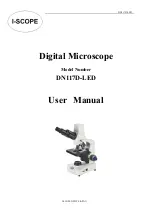
CHAPTER 2 - SAMPLE PREPARATION
Carl Zeiss
Sample Mounting for LSFM
Lightsheet Z.1
22
000000-1790-528
02/2013
A few points must be taken into account when choosing a particular mount:
−
Compatibility. This is a crucial issue. The mount must be compatible with the object you want to
image (chemistry, temperature etc.), but it must also be compatible with the stage holder.
−
Stability (mechanical, optical, chemical).
−
Tightness. In the case of embedded samples, once the gel has solidified, the cylinder of gelling
agent is pushed through the capillary out of the distal end by a plunger fitting into the capillary.
The system must be air tight to avoid air entry leading to a displacement of the gel rod. The
plunger can be sealed with a drop of wax, acrylamide or nail polish, i.e. anything that prevents the
plunger and hence the agarose containing the sample from moving.
−
Cost.
2.3.3
Sample Holder
For technical description of the sample chamber, hearting devices and sample holder, you can refer to
CHAPTER 1 HARDWARE
.
Once the specimen is prepared and properly labeled, it is ready to be imaged. While in conventional
imaging there is a suitable platform on which to place the glass slide or the chamber, in LSFM the object
must be held from above via the sample holder. Depending on the size of the sample there are two
different types of sample holders available: sample holder for capillaries and syringes (Fig. 14/
C
-
F
and
I
).
Always use the minimal cylinder diameter necessary for your specimen size to avoid excessive amounts of
agarose.
The largest sample holder has been designed to accommodate a 1ml syringe that can be inserted from
the top with a plunger that can be operated once the sample holder is mounted on the stage. Once
inserted, the syringe is perfectly fitted to the sample holder as the two flaps used for injection fit the
upper part of the holder. In this way the object support is well maintained, an essential issue for imaging
and multiview imaging as the object is moved through the light sheet by the stage.
Capillaries have been extensively used to image small embedded objects, as hooks for very large objects,
and as support for enclosed objects, so the capillary has become commonly used for LSFM sample
embedding.
Capillaries are made of glass. They can break. They are also sliding when wet. Please handle
them with care and dispose them properly.
Содержание Lightsheet Z.1
Страница 1: ...Lightsheet Z 1 Operating Manual February 2013 ZEN 2012 black edition ...
Страница 4: ......
Страница 170: ......
Страница 427: ...Lightsheet Z 1 Overview ...






































